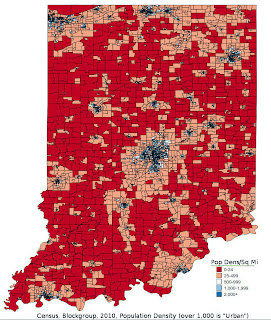The claim of "more spending per student than any other country" is often followed by the complaint about teacher's unions forcing us to pay more than any other country for teacher salaries, yet preventing us from firing bad teachers. While the former claim is partially true, the latter is not. Leaving that debate for another discussion, it is important to understand the spending data. First, Graph 1 shows "all" education spending, which includes pre-primary all the way through tertiary spending, including vocational spending. It also includes all funding sources--local government through federal, and includes private funding (spending is converted from national currency to PPP by GDP for interstate comparison).
However, separating tertiary spending from primary/secondary spending produces a slightly different picture (note also that this data is just from a one-year snapshot of 2010).
No longer the biggest spender in these categories, we are clearly in the top spending cluster, although all of the top 8-12 countries are relatively close to each other (except the top-spending country, Luxembourg, whose GDP/capita is just less than twice that of the US, by far the largest of the OECD countries). Looking at tertiary education, i.e., university and college spending (excludes vocational training), the comparison looks quite a bit different.
What we can now see, is that while our national conversation about education is typically centered around primary and secondary failings, linked to high levels of comparative spending, our actual spending compared to other countries is greatest for tertiary education. I will come back to the issue of primary/secondary school funding, to suggest a clarification for how we can still be at the top of the cluster of spenders, but still be producing poor results. As for tertiary spending--where is all that money going? While an excellent question, a number of recent analyses have indicated that US spending on college sports (and here, and here), as well as administration/bureaucratic costs (and here) far outpaces other countries, and has little benefit to student learning, which is arguably the main reason for the existence of the university. Note that the skyrocketing US tuition is not going to most faculty, especially the adjunct faculty who comprise over 50% of teachers in most state schools--many of those part-time faculty are on food stamps and receive no benefits or job security.
The above chart clearly shows that we in the US are spending far more than any other country on tertiary education--but why is that? Are there more of us going to college? Are we going to college longer? It's definitely not the former. In fact, we have one of the lowest college-participation rates of all of the OECD countries.
So we are spending far more than any other country on tertiary education, but sending almost the lowest proportion to tertiary education. The problem would seem to be the costs themselves. Indeed, most OECD countries provide free, or almost free, tertiary education: France, Denmark, Sweden, Iceland, Finland, Norway, Belgium, Spain, Italy, Austria, Poland, Turkey, Mexico, and Slovenia. The graph below separates the tertiary institutions into two categories--public and private--with average cost per student for each (countries with no bar data either are completely free, as listed above, have no private colleges, or did not supply data). As can be seen, the cost of a U.S. education, especially for private colleges, far supersedes any other OECD country.
Finally, getting back to the question of primary/secondary funding, if we are spending near the top of the cluster, there is the persistent issue that our students are performing at a mediocre level compared to other countries. Intuitively, this must be an issue of how the money is being spent. But perhaps a better question is "where" the money is being spent, speaking geographically. A recent analysis showed that, unlike almost every other OECD country, our money is being spent where our wealthiest students reside, while we strip funding for our poorest students. The OECD data shown below supports this proposal, to the extent that we have created an educational system whereby the majority of funding comes from local sources, predominantly property taxes, whereas other countries have far greater input from federal sources for more equitable distribution of national resources. Unlike the graph above for primary/secondary spending, which was only for 2010, the graph below is an average of 2006-2010, to generate a broader representation of spending. Here it is evident that we are close to Luxembourg for spending, far above the other countries. However, it is also clear that we shift the majority of our funding to local sources, with relatively little federal funding.
One might notice that several countries with high PISA scores also have a large percent of their education budget from local sources, such as Norway, Denmark, Finland, Iceland, Canada and the UK. The critical difference is that in all of these cases, their levels of inequality (GINI) are far lower than that of the US. So while all countries have areas that are poorer, and some are wealthier, in the US there is tremendous geographic inequality, large islands of poverty, and large islands of wealth. In areas of poverty, where education is funded by property taxes, there is very little money coming into schools, and relatively little federal money to make up the difference. On the contrary, areas of wealth have the ability to collect sufficient funding for a wide variety of educational supplements, infrastructure/development investment, and recruiting of the best teachers. In countries with low-GINI there are far higher levels of equality throughout the population and the geography, with far higher spending on social safety net systems designed to generate equality of opportunity and access to resources. I will leave this for another time to demonstrate myself--in the meantime, others have already analyzed the OECD and US data, arriving at the same conclusion.











